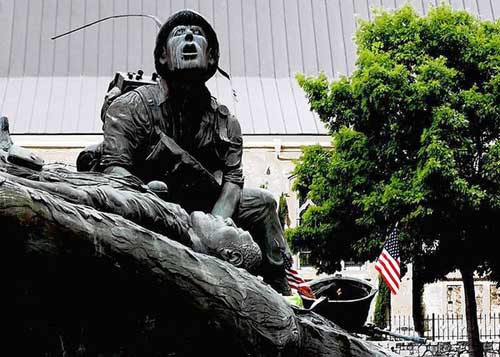
 Sculpture News at SculptSite.com
Sculpture News at SculptSite.com
Austin Deuel Sculpture: A monument to memory |
| The Baltimore Sun By Madeleine Mysko San Antonio's "Hill 881 South" reminds us what Memorial Day is really about I am ambivalent about Memorial Day. On the one hand, it offends me that, for most Americans, Memorial Day has become just another holiday weekend - a getaway to the beach, the opening of the pool, a sale at the garden center. I once served as an Army nurse, in a stateside hospital to which wounded soldiers were evacuated regularly. So for me, the "memorial" part of the weekend always overshadows the "holiday" part. While I'm firing up the grill and watching for the kids and grandkids to arrive, remembrance rolls in out of the blue, like a solemn cortege. Suddenly I'm thinking of soldiers who suffered and died - and not just the soldiers of my own generation. I think, too, of the families they never came home to. But on the other hand, I'm equally offended by displays of patriotism and military splendor - flags, marching bands, the Blue Angels breaking the sound barrier overhead. To my way of thinking, Memorial Day (which was once called "Decoration Day," when women would carry flowers to the graves of the fallen) ought to be quietly mournful. Just once a year, couldn't we gaze directly at the precious lives lost? Couldn't we quit numbing ourselves with all that loyalty to the nation for which lives are still being sacrificed? A few years ago, I visited San Antonio, a city of several large military installations. I went to the veterans' memorial there, an enormous bronze sculpture that depicts two soldiers in realistic detail. One soldier is mortally wounded, and the other is calling for help by radio. The name of this sculpture is "Hill 881 South." The artist, Austin Deuel, served as a Marine illustrator. Apparently, one day in 1967, Mr. Deuel made a quick sketch of something he saw in the thick of a terrible battle. Nineteen years later, he worked that sketch into the largest memorial of its kind in this country. I have a photograph of "Hill 881 South." Sometimes I hold it in my hands and contemplate its crucial details: Veterans of that battle on Hill 881 South have determined that the wounded soldier in Mr. Deuel's sculpture is most likely Pfc. James Arthur Randall, who did not survive. The radio operator is said to be Cpl. Donald Hossack, for whom one day a helicopter did come, whisking him home to the rest of his life. As for the larger-than-life radio operator, the one Austin Deuel captured forever in his enormous, bronze sculpture: It comforts me to hold his likeness in my hands. He cannot let go. His fingers are still pressed to the pulse of fallen ones - of the ones who may be falling even now, as we check the skies for fair weather and fire up the grill. Madeleine Mysko, a Towson resident, is the author of the novel "Bringing Vincent Home." Her e-mail is mmysko@comcast.net. |
 The words of Madeleine Mysko capture the essence of the meaning of Memorial Day, through this Austin Deuel Sculpture Monument. What a wonderful read, thank you Madeleine, and thank you to all who have served and our serving our great country, the United States of America. |
 "Hill 881 South" by Austin Deuel |
More Sculpture News ....
Submit your SCULPTURE NEWS.
It's easy, just send us an e-mail
(click on Submit News in the left menu) with your pertinent information along with images, we'll take care of the rest. Sculpture makes our world a much better place in so many ways!
SculptSite.com, along with Sculptors and their creative genius all helping to bring the beauty and message of Sculpture to a hurried world.

